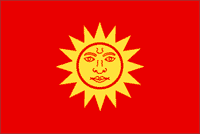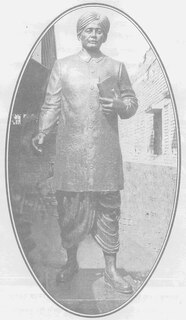History
Beginning of the Koch dynasty
In the 16th century, Bisu, the son of a Mech father and Koch mother [17] came into power in the lower Brahmaputra valley, who after being Hinduised acquired the name Biswa Singha. [18] Biswa Singha united the different Tibeto-Burman linguistic groups (Bodo-Kachari)— Koch, Mech, Garo, Rabha etc. of the region under the banner of Koches [19] [14] and established the Koch dynasty of the Kamata kingdom. Under his sons Nara Narayan and Chilarai, the Koch dynasty came to control the entire Brahmaputra Valley subjugating the Ahoms, Kacharis, Tripuris. The reign of Naranarayan saw the increase Hinduisation of the Koch royal family, the introduction of fourfold caste system [20] and the advent of Srimanta Sankardev who preached the ekasarana nama-dharma [21] led to their rapid transformation from the followers of tribalism to Shaivism and Vaishnavism. [22] But the introduction of Hinduism came in conflict with tribal religious beliefs of the Koch, Mech and Kachari people of the Koch-Kamata kingdom, [23] so the conversion of the masses into Hinduism remained relatively slower than in the Koch royal family. [24] The death of Naranarayana saw kingdom split into two — Koch Hajo and Koch Bihar. Aggressive attacks from the west and the east, led to Koch Bihar becoming part of the Mughal Empire and Koch Hajo of the Ahom kingdom.
Late 19th century and early 20th century
In 1891, a section of Koches who were at tribal or semi-tribal stage in present North Bengal and Western Assam tried to dissociate themselves from their original ethnic stock by describing themselves as Rajbanshi or Vratya Kshatriya. Among the measures emphasized by the leaders for the Kshatriyisation of Koches was the wearing of scared thread, reduction in the days of mourning for the death of parents from thirty days to twelve days and also the change of surnames to Roy and Barman. The process gained movementum in 1910 under the leadership of Panchanan Barman, the Koches got the legal Kshatriya status of Rajbanshi after getting recognition from different Brahmin pandits of the region and lost their tribal identity thus making them separate from their Koches origins. The district magistrate gave permission to use surnames like Roy, Barman, Sinha and the Kshatriya status was recognized in the final report of 1911 census. The movement manifested itself in sankritising tendencies with an assertion of Aryan origin and striving for higher social status by imitating higher caste customs and rituals.
Historian Arup Jyoti Das claims that this new-found status resulted in the Koch upper class abandoning tribal traits: such as matrilineality and their Tibeto-Burman language, and calling themselves Rajbongshi. [28]
Today the Koch-Rajbongshis are found throughout North Bengal, particularly in the Dooars, as well as parts of Lower Assam, northern Bangladesh, the Terai of eastern Nepal and Bihar, and Bhutan. [29]
Lifestyle and culture
According to a 2019 research, the Koch Rajbongshi community has an oral tradition of agriculture, dance, music, medical practices, song, the building of house, culture, and language. Ideally the tribe transfer the know-how from one generation to another. [31]
The Koch Rajbongshi community had traditionally been a largely agricultural community, cultivating mainly rice, pulses, and maize. Rice is the staple food for the majority of the population. Even in the 21st century, a large portion of this community still adheres to a rural lifestyle, though urbanization is on a constant rise. The food consumed and the diet pattern is similar to all the Koches of Assam, West Bengal, Nepal, Bangladesh, Meghalaya. Rice and Pulses are consumed on a regular basis along with vegetables and bhajis (fries- mainly potatoes). Typical is the Dhékir sāg and naphā sāg, two types of leafy vegetable preparation, mostly boiled with very little added oil, out of newly born shoots of fern leaves. In lower Assam, a vegetable preparation of bamboo shoots is also consumed. Consumption of stale rice or pantha bhāt is common within Koch Rajbongshi. Cooking is mainly done using mustard oil, though sunflower oil is sometimes used. As far as non-vegetarian foods are concerned, the Koch Rajbongshi population consumes a large amount of meat and eggs unlike other neighborhood populations from the Bengal region, who consume a large amount of fish. Goat meat and sheep (if available) is generally consumed, and consumption of fowl meat is discouraged as a result of Sanskritization, though these taboos have eroded over time. There were rituals involving sacrificing pigs in Ghordew puja, and ducks in Laxmi puja. Eggs of ducks and poultry are consumed. Ducks and Fish are also consumed but not in very large numbers. The rivers of northern Bengal does not sustain large varieties of fishes because of its non-perennial nature. However, in lower Assam areas, large rivers like the Brahmaputra sustain large varieties of fish which becomes an important part of the dietary habit of the Koch Rajbanshi living there.
Home design of a typical Koch Rajbanshi home is essential for the rectangular pattern, with an open space (egina/aingna) in the middle. This is done mostly for protection against both wild animals and strong winds. A Thakurghor of Manasha or Kali Thakur at the entrance is must in every Koch-Rajbongshi house. The north side holds the betel nut and fruit gardens, the west contains Bamboo gardens while the east and the south is generally left open to allow sunshine and air to penetrate into the household. Though such a pattern is more prominent among the landed gentry.
Traditional attires of Koch-Rajbongshis are mainly Patani, Agran, Angsha, Chadar, Lifan, Phota, and various other traditional costumes being weaved at their traditional handloom in their home. The traditional clothing for men is Angsha and Jama , while for women is Bukuni-Patani, Phota, Agran, Angsa, Lifan; Chadar a piece of cloth tied around the chest that extends up to the knee. Lifan or Phota are worn like a wrapper. The Koch Rajbongshi Tribe has still preserved their age-old ethnic attires and is being used on a regular basis as their common costumes, The Koch Rajbongshis prefer to wear their traditional attires in-spite of the fact that the modern costumes are widely available. [32] [33]
Music forms are integral part of Koch-Rajbongshi culture. The main musical forms of Koch-Rajbongshi culture are Bhawaiyya, Chatka, Chorchunni, Palatia, Lahankari, Tukkhya, Bishohora Pala among many others. Various instruments are used for such performances, string instruments like Dotora, Sarindra and Bena, double-membrane instruments like Tasi, Dhak, Khol, Desi Dhol and Mridanga, gongs and bells like Kansi, Khartal and wind instruments like Sanai, Mukha bansi and Kupa bansi. [34]












